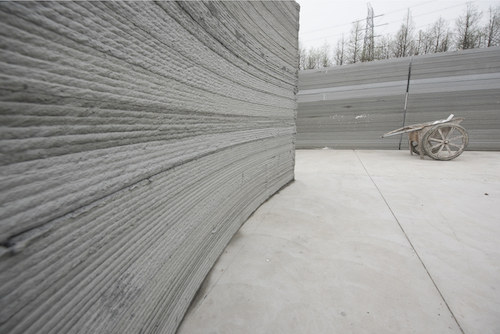If we told you ten years ago that a house could be completely fabricated on a printer, would you have believed us? The time has finally come! In 2017, construction was completed on the 3D Print Canal House, a house totally fabricated on a 3D printer. While 3D printing in construction isn’t necessarily ready to churn out subdivisions across the U.S. just yet, there are some exciting trends that MLM Incorporated is following. The future of 3D printing in construction is unfolding right now. Here’s what to keep an eye on.
The History Of 3D Printing In Construction
The history of 3D printing, also referred to as additive manufacturing, is much like the process itself, different parts of the whole were developed and then came together.
The first bricks were laid, literally, between 1950 and 1995, with a robotic bricklaying process. Around the same time, pioneers began exploring automated construction, which leads to Japanese companies Shimizu and Hitachi making advancements in automated fabrication to solve the dangers present in high-rise buildings.
Even though these efforts were not sustainable due to problems with creating materials onsite, these advancements sparked many ideas that led to the first generation of 3D printing in construction between 2000 and 2010, mostly of building separate components as opposed to entire buildings.
As the second generation of 3D printing kicked off in 2010, more ideas poured into the market.
- March 2013: FreeFAB Wax, an engineered wax used to create a 3D printed mold for precast concrete and other cast-able materials, is invented
- January 2015: Swedish construction company Skanska revealed a mansion-style villa and a five-story tower that used 3D printing construction materials
- May 2015: SPECAVIA, a Russian company, announces it will begin selling three models of 3D construction printers for printing small architectural forms to printing buildings up to 3 floors at the larger end
- September 2015: The U.S. Army Corps of Engineers throws its research hat into the ring, focusing on developing 3D printed construction materials like Jersey walls, culverts, bunkers, and even an entire barracks
Other advances across the globe led to the construction of the Autonomous Robotic Construction System (ARCS) by S-Squared 3D Printers, Inc, headquartered in Long Island, New York. In just 36 hours, this printer can construct a 1,490 square foot concrete printed home.
And in May of 2021, the first 3D-printed clay house, Tecla was completed.
How Does 3D Construction Printing Work Today?
3D printing in construction uses enormous printers with nozzles that extrude concrete using a gantry or robotic arm system.

These days, the primary technique of 3D printing is contour crafting (CC). This construction process moves construction from the traditional methods to a layer-by-layer method that is more affordable, fast, and flexible.
Contrary to the name, 3D concrete printing does not use straight concrete since it would clog the extruder. Most concrete printers combine concrete with other materials that not only increase the strength of the material and final building but also make it easier to work within the 3D printer itself.
So how does it all work?
As with traditional construction methods, architects and engineers first design the building and create the floor plan.
Next, a concrete 3D printer is programmed to create a specific form, shape, or entire structure. A g-code directs the extruder through the entire process.
Although it may seem that the need for construction workers is diminished with the use of 3D printing in construction, the opposite is true. Professional tradespeople are needed to prepare the ground for the printer and to make sure that surfaces are flat and level. Concrete is mixed on-site, and rebar enforcements are added as needed, too.
Workers set up the printer on its rails and ensure that it is stable and ready to go before the concrete mixture is added.
If a house or office is being constructed, windows and doors are part of the program too. A special robotic hand operates next to the extruder nozzle and stands ready to insert windows and doors in their proper place.
Benefits
3D printing in construction is not likely to completely replace traditional building methods any time soon, but there are some benefits in both commercial and residential applications. 3D printing offers affordable and remarkably strong construction that is capable of quickly erecting structures. For areas hit by natural disasters that wipe out housing, this technology could be a lifeline.
3D printing in construction is also a cost-efficient way to exactly reproduce complicated geometric forms or structures that would prove challenging with traditional methods.
This method of construction is also incredibly environmentally friendly. There is little, if any, waste of construction materials in the building process. 3D printing in construction also eliminates the need for architectural molds, as all components of a structure can be built on the spot.
Challenges
3D printing in construction is far from perfect. There are currently no enforceable codes for 3D printing in construction. While this allows for a lot of creativity right now, this also means that there are no safety standards, too.
Additionally, the materials available for 3D printing of houses or architectural components is limited to concrete and plastics. If a building requires steel or wood, the 3D printer can’t complete those portions.
Finally, the whole process is so new that many architects and engineers do not yet have the skills to design for it. This is a new technology, and any craftspeople who went through their training before it evolved will need to do some work to catch up.
Is 3D Printing In Construction Safe?
One of the main concerns of any new construction process is safety. Currently, no federal building codes exist to regulate the safety of 3D printing in construction, but there are a few researchers taking a closer look.
Unsurprisingly, the structural integrity of 3D printing in construction depends largely on how it is laid down. What is shocking is that the strongest pattern is straight from the deep blue sea – patterns that mimic lobster shells appear to have much more strength than any other pattern.
Because this process is so new, there have been relatively few deep dives into fire safety of 3D printed buildings and their components, either.
3D printing in construction trends have leaned more toward habitable buildings, but that has changed. In 2021, researchers identified the exact parameters for reliably flame retardant walls in 3D concrete printing. For example, they found that proper wall density and the addition of Rockwool insulation packed into gaps or crevices allowed buildings to burn for up to five hours and still retain 45% of their structure.
3D Printing In Construction Examples
From individual elements to entire complex houses, 3D printing in construction examples are more common than you might think. Here are some of the fascinating ways it’s being used today.
Concepts and models
The simplest entry point into 3D printing in construction is in its use for creating concepts and models. Gone are the days of finicky, built-by-hand scale models of projects. A 3D printer can take a computer-aided drafting (CAD) model and make the building a reality in just a few hours, depending on the size.
This process is great for large commercial projects that have intricate architectural features or geographic considerations.
Architectural elements
If an entire 3D printed house doesn’t appeal, 3D printed walls and architectural features are gaining in popularity. 3D printing in construction got much of its start in these structural elements, and they continue to be a thriving part of the industry.
3D printed concrete
3D printed concrete is as strong, if not stronger, than traditionally mixed concrete. Concrete is already a durable and structurally sound material, but properly patterned and poured 3D printed concrete increases those characteristics.
3D printed houses
Because the technology is so new, it’s hard to know exactly how long 3D printed houses will last. Many estimates put their life somewhere around 50 to 60 years, but this is only an estimate. 3D printing construction materials just aren’t vulnerable to the elements in the same way that wood is. They resist pests, mold, rot, and other types of water damage.
Because 3D printed houses do not have elements that are susceptible to decay or rot, it’s possible they could last even longer.
Expand Your Normal With MLM
Whether you are looking for a traditional remodel or want to explore what’s next in high-tech construction, MLM Incorporated in Louisiana is on the leading edge of construction trends and can answer any questions you have about 3D printing in construction.
Get in touch with us today to see how we can help with your project!

